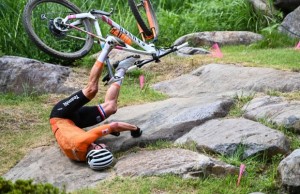Tips to overcome the fear of falling off a bike
The fear of falling when riding a bike can be extremely debilitating, blocking us in such a way that we even know of cases of cyclists who have stopped a car to ask if they could be taken down a certain hill because they were unable to get on the bike and ride it. These are fears that we can overcome with work.

Overcome your fear of falling to fully enjoy cycling
Cycling is a wonderful sport but it has a small problem, it is done on a two-wheeled machine that moves in a perfect balance of forces. When this balance fails, we can end up on the ground, most of the time without more harm than our pride and various scrapes, but in other cases suffering serious injuries such as broken bones.
Thinking about the consequences of falling makes many cyclists ride in constant tension when they get on the bike, which not only undermines the essential forces needed for pedaling but also prevents them from fully enjoying the experience. This is more common the later a person starts cycling. Those who have been riding since childhood have passed that stage where they fear nothing and have gained technical mastery of the bike and experience in falls, which usually makes them not fear falls but see them as part of the cycling game.
RECOMENDADO

What would you do if you won the lottery? This cyclist bought himself a €20,000 bike

The best exercise routine to do at home

Benefits of training in the cold

The cyclist's patience: how long, gentle training sessions build your best season

Tips for cycling in the rain

25 cycling gifts ideas to get it right

However, those who discovered cycling at an older age have not had that technical training and do not have the bike handling skills. For those who choose the road, we prepared some time ago this article with several tips for descending better that may be useful to understand the technical aspects of this modality. Those who choose fat tires can find several tips, this time from the great Nino Schurter, which can be very useful.
Advantages of overcoming the fear of falling
Obviously, overcoming these fears is necessary if we want to fully enjoy cycling beyond just pedaling, if only to be able to admire the surroundings instead of constantly worrying about staying on our machine, which can be really exhausting.
However, beyond this, cycling without fear also allows us to go from suffering to enjoying certain aspects of cycling that were previously unattainable. We assure you that there are few experiences as exciting as descending a hill linking one curve after another smoothly, or choosing on sight the ideal line on a trail and starting to draw with the bike the line we imagined in our head, feeling like we are floating from rock to rock while absorbing the irregularities with our arms and legs. Not to mention the joy of facing a singletrack at full speed with our gravel bike, pushing every curve to the narrow width of the trail.

Experiences that you are missing out on if you ride with fear, and that are undoubtedly a big part of the thrill of cycling. Not everything has to be suffering and pushing our legs uphill, as these situations are often the well-deserved reward after a hard effort.
But, in addition to being able to discover these aspects, which are off-limits to those who are afraid of falling, one thing is usually true: cycling with fear often results in less safe riding. That is, if you are constantly thinking that you are going to fall, it is likely that you will end up falling, which only reinforces that fear. A vicious circle that for some means eventually giving up cycling.
Tips for not being afraid of falling on a bike
The problem is that fear is an irrational feeling towards what we cannot control, so it is not as simple as telling someone: "don't be afraid". That doesn't work. Instead, the first step must be to give cyclists tools to understand how the bike behaves in different situations and how what they do affects the bike's reactions.

If the cyclist knows that if they do a certain thing the bike will behave in a certain way, they will begin to have tools to control what they perceive as uncontrollable. This involves making conscious acts that are often taken for granted. For example, knowing that if we turn the handlebars to the left, the bike leans to the right and vice versa; or that if we change the position front to back we alter the weight distribution on the wheels and affect the bike's traction and turning capacity.
Of course, theory alone is not enough. We must put these explanations into practice and there is nothing better than doing it explicitly and not having to apply what we have learned when we find ourselves in the middle of a rocky path in the mountains. Finding a park or a square with steps or a wide surface where we can set up cones to practice bike control will be invaluable in gaining confidence and starting to apply the theory in a controlled environment where it is difficult to get hurt if we fall.

From there, little by little, we will apply what we have learned on real routes and see how gradually the confidence we have gained in our technical training shines through. Practicing in a real environment will be beneficial, so it will be good to follow someone who can guide us and show us the correct line, giving us the confidence to know that if they have passed through a place, we can too, always with increasing difficulty.
Sometimes fear does not arise from ignorance but comes from having suffered a fall with serious consequences, especially if we have suffered a broken bone that has kept us off work for several months. It is inevitable to dwell on the idea that we cannot fall again or that we do not want to go through it again, which reduces our confidence and makes us ride tensely on the bike.
Some time ago, asking a professional road cyclist about this, he explained that his trick to not be afraid after a fall was that, when he returned to the bike after being discharged, he went to his favorite descent, the one he knew by heart, and went full speed down it to dispel any ghosts from his head.

Without being so radical, it always helps to go back to the place where we fell and see that we can overcome it without any problem, even if we have to stop, analyze, and try several times. In fact, it is extremely important after a fall to do a thorough analysis to find the cause of it. Thinking about what we did wrong, if it was something we could have avoided or the chances of a similar circumstance happening again.
Knowing if we fell because we braked too much in the middle of a curve, because we hit a rock, because we entered too fast, or because we did not react properly to an unexpected event can help us avoid making the same mistake when faced with a similar situation. However, if we fall and are unable to explain why it happened, in our mind it will become one of those things we cannot control, which translates into fear.
In any case, we cannot completely eliminate fear because when we are cycling, there is always a small percentage of situations that we cannot control. However, it is this small point of respect that should prevent us from exceeding our limits and allow us to enter difficult areas or descents with at least 99% control.

As you can see, beyond the technical skills in bike handling, which need to be practiced continuously to reinforce and internalize them so that they become resources that come naturally when needed, the mind is the main limiting factor in overcoming the fear of falling. Turning what seems uncontrollable into a conscious act and knowing how the bike reacts to each of our actions will be key to gaining the necessary confidence to dispel those fears. In any case, let us not forget that falls in cycling come sooner or later, but we must be clear that in the vast majority of cases they result in nothing more than "scratches and dents". Besides, if we ride relaxed on the bike and not tensed by fear, it is less likely that we will get hurt if we end up on the ground.